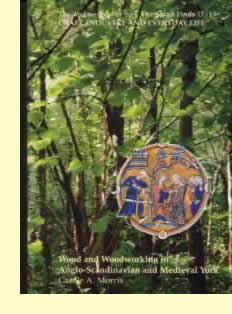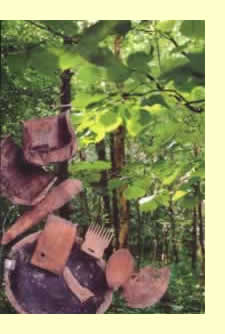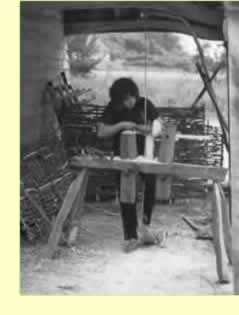|
Archaeology
 WOOD
AND WOODWORKING IN ANGLO-SCANDINAVIAN AND MEDIEVAL YORK WOOD
AND WOODWORKING IN ANGLO-SCANDINAVIAN AND MEDIEVAL YORK
by Carole A, Morris PhD
(paperback) 408 pages, B&W line drawings throughout, B&W and colour photos (2000) Out of print - temporarily unavailable This report presents over 1500 domestic and utilitarian
artefacts made of wood from six locations in the city of York - including
complete objects as well as woodworking waste, unfinished products and
woodworking tools. The date range covered by the assemblage is c.850-post
Medieval. The bulk of the material is of Anglo-Scandinavian date (c.850-late
11th century) and was recovered from excavations of well-preserved structures
and associated features at 16-22 Coppergate, the Coppergate Watching Brief
site and a site excavated in 1906 at the corner of Castlegate/Coppergate.
Medieval material from those sites and from the College of the Vicars
Choral at the Bedern, the Bedern Foundry site and 22 Piccadilly is also
included, as is a small amount of late-post Medieval material from some
of the sites. Taken together, these sites produce a very detailed picture
of the production processes of many different types of wooden artefact,
but especially those produced by lathe-turning, and the many uses of different
forms and species of wood in the daily life of the people of York over
a period of nearly an entire millennium.
The report includes a brief description of the sites from which the material
was recovered, and the material itself. This is followed by a discussion
of the particular conservation techniques used to preserve these wooden
assemblages, and of the specially-prepared wet wood laboratory and equipment
developed to cope with the conservation of waterlogged wooden objects
varying from several centimetres to several metres in length! On-site
retrieval, temporary storage, conservation, reconstruction and permanent
archive storage of the artefacts is discussed.

The rest of the report presents the material
in two main sections. The first section, 'Craft and Industry', describes
and evaluates the evidence for the production of wooden objects. This
involves not only the exploitation of local woodland, various types of
woodworking tools and general woodworking techniques, but also the two
major vessel-producing crafts of lathe-turning and coopering. Most of
the excavated evidence is for the manufacture of lathe-turned wooden bowls
and cups during the Anglo-Scandinavian period at 16-22 Coppergate in the
form of part of a lathe, roughouts, unfinished discarded vessels, waste
products and an iron turning tool. Possible locations of turners' workshops
in Coppergate are discussed and their craft linked with the street name
'Coppergate'' - 'the Street of the Cup-turners'. Coopering is mainly represented
by finished products.
 (image
on right) The author turning a wooden bowl on her pole-lathe (outside
Bayleaf house) at Weald and Downland Open-air Museum at Singleton
(for
more about the Bayleaf project) (image
on right) The author turning a wooden bowl on her pole-lathe (outside
Bayleaf house) at Weald and Downland Open-air Museum at Singleton
(for
more about the Bayleaf project)
The second section, 'Everyday Life', presents the extremely
wide range of wooden artefact types which were not necessarily made on
the sites under discussion, but which were used (and discarded) there
for a variety of functions. These include domestic equipment and utensils;
boxes and other enclosed containers of various sizes and shapes; furniture
such as garderobes and stools; personal items such as pins and combs and
wooden-handled knives; manual and agricultural implements from spades,
shovels and mattocks to parts of a plough; implements used in the manufacture
and handling of fibres and textiles, artefacts used in other non-woodworking
crafts such as leatherworking, riding, the handling of ropes and cords
etc.; wooden components of games and pastimes such as gaming boards and
parts of musical instruments; small wooden components of internal or external
structures such as roof shingles, window openings, door latches and panels;
pegs of various kinds and re-used boat timbers; and miscellaneous wooden
artefacts whose uses are as yet unidentifed.
Finally, a short discussion attempts to bring together various
general conclusions from the study of this material.
A catalogue of all the wooden artefactual material recovered from the
sites and a provenance concordance completes the report.
Reviews
Since James Graham-Campbell's 1996 review of the path to
publication of York's Anglian and Anglo-Scandinavian archaeology , much
has happened. Tweddle, Moulden and Logan's important synthesis of Anglian
York (AY 7/2) has provided a much needed review of the background to the
more widely known Anglo-Scandinavian archaeology, whilst Richard Kemp's
report on the Fishergate excavations (AY 7/I) has provided a detailed
view of the physical aspects of Anglian settlement. Perhaps the greatest
achievement of the York Archaeological Trust, however, has been to bring
to publication the majority of the material derived from the Coppergate
excavations so ably directed by Richard Hall between 1976 and 1981. Volumes
on other materials, including pottery (AY 16/5), ironwork (17/6) and,
more recently, bone, antler, ivory and horn (AY 17/12), are already established
as invaluable catalogues for students of early medieval material culture.
The volume reviewed here follows the format of the latter, as an A4 monograph
facilitating more extensive visual representation of the subject matter
of each.
Carole Morris's volume on the objects ofwood and the evidence
for their manufacture is a splendid production which allows the nature
of occupation of an earlv medieval town to be viewed alongside the material
culture of other European towns where waterlogged deposits have preserved
an array of objects not normally preserved in the British Isles. Indeed,
the range, if not quantity of wooden material culture compares well with
that from Novgorod. The volume is divided up with the first section detailing
the evidence for woodland exploitation, woodworking tools and techniques,
lathe turning (finished and waste products), fragments and offcuts and
coopered vessels. The second section considers domestic equipment and
utensils, boxes and containers, furniture, personal items, agricultural,
textile working and other tools, games and pastimes, structural finds,
pegs and miscellaneous objects. The incorporation into the book of much
of Morris’s Ph.D. research makes for an informed study of much more
than regional import, for this is a research volume of international
importance. The breadth and depth of research is impressive as befits
the material with which it deals (see for example the discussion of ‘Building
Accessories and Structural Fragments'). The author’s own experience
of working with her chosen material is evident throughout the text, and
a rare combination of both practical awareness and academic approach is
achieved. Despite the overall emphasis on the pre-Conquest archaeology
of York, Morris's volume contains a good deal of material from later medieval
contexts, including ‘probably the most perfectly preserved complete
medieval bucket found on any site in Britain' (from early 15th-century
levels at Coppergate).
Overall, the presentation of this volume is of the highest
standard and the price is very reasonable. The illustrations are excellent,
particularly of the wooden objects (largely by Kate Biggs) The overall
style and quality of presentation, including the eye-catching cover design,
makes this volume a pleasure to handle and use.
Andrew Reynolds
Abridged from review published in Medieval Archaeology 45, 400-401 (2001)
Being old, tired and past it these days, it takes quite a lot to bring
a smile to my poor sad old face. This book managed it. My interest in
wood and woodworking obviously means that I am biased - but what an
achievement this book represents. There is a certain amount of solid
archaeology for those who need or want it, but there is an awful lot for
normal people as well.
Instead of grouping finds together according to where they
were found, Carole Morris groups them according to what they are and what
they do. After relatively short sections on the archaeology and conservation,
she gets down to looking at material under two main headings: Craft and
Industry and Everyday Life. The first section deals mostly with techniques,
especially turning and coopering, and tools. The second section brings
us glimpses of ordinary people doing daily tasks: wooden spoons and spatulas,
buckets and knife handles, boxes and lids, bits of furniture, lavatory
seats, combs and fragments of musical instruments.
So who will enjoy this book? Wood and woodworking specialists
are a small but obvious group of readers. Any modern craft worker,
however amateur, would be fascinated by the glimpses of these ancient
crafts. The archaeological material is beautiful (and beautifully
drawn), and illustrations from early manuscripts show this material being
produced and used. Instead of pages and pages of pottery or animal bones,
we find ourselves looking at door latches and spades, rakes and ploughs,
wooden pins and part of a beautifully decorated saddle. Anyone who has
tried to imagine how people lived in the past will find plenty to flesh
out their imaginings here. Although written for archaeologists it will
appeal to anyone who is interested in life.
Maisie Taylor (a specialist in ancient
wood based at Flag Fen)
From review published in British Archaeology 58 (2001)
www.britarch.ac.uk/ba/ba58/book.shtml
 Excellent
book for woodworkers Excellent
book for woodworkers
This is an excellent text, especially
for woodturners interested in documenting period styles. At 450 pages,
this beautiful book contains an amazing amount of detail concerning
the wooden artifacts that have been found. As the focus of this book is
on the artifacts dating from the 10th through 15th centuries, there is
an impressive amount of interest to SCA [Society for Creative Anachronism]
woodworkers.
This book should be of even greater interest to woodturners, as it has
one of the best sets of diagrams showing period turned bowls and cups
that I have seen, including inner and outer profiles. You can see a small
sample here. In addition, there are multiple section on technique, including
use of a bow lathe, methods used for making cups and bowls, and even how
they would cut and use logs for various projects.
There is simply such a wealth of information in this book that I can't
begin to adequately list its contents, but an abbreviated list of highlights
include:
Woodturning forms, tools and a discussion of their use.
Cask, barrel and bucket construction, including the only intact well-bucket
from this period known.
Wooden spoons, spatulas, pot lids and other domestic woodware.
Boxes, including lathe turnes boxes.
Wooden game boards and pieces
Garderobe seats (yes, really).
Breakdown of wooden items found by type of wood.
If you have any interest in Medieval woodworking, you must get this
book.
Glenn Basden Sacramento, CA, USA
Reviewed on Amazon.co.uk:
23 March, 2001
|
 Archaeology
Archaeology
 Archaeology
Archaeology